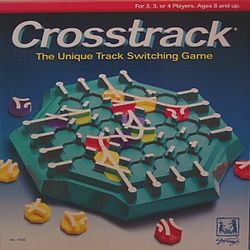- Crosstrack
-
Crosstrack
Game boxPlayers 2-4 Age range 8+ Setup time 30 seconds Playing time 10-30 minutes Random chance None Skill(s) required Tactics, Strategy Crosstrack, the "unique track switching game", is an abstract strategy game created by Shoptaugh Games in 1994. Players place special track pieces onto an irregular octagon board, winning by being the first to create an unbroken path between two opposite sides.
Contents
Rules
All games
Play begins with an empty board, and players choose certain color groups as their individual "stocks". To win, a player must connect any two opposite sides of the board in an unbroken path, regardless of whose pieces the path goes through. Game players move according to three "basic rules", one and only one of which is to be executed every turn:
- Players may place a piece from their own stock onto an unoccupied spot on the board.
- Player may rotate a piece already on the board to any chosen orientation, if they placed it there.
- Player may move one of their pieces already present on the board to any unoccupied space in any orientation.
Two-player game
In a two player game, each player chooses two colors (two sets of six) to form their stock.
Three-player game
In a three player game, each player chooses one color (six shapes) to form their stock, and the last color is set aside as a common stock. Any player may play from the common stock on their turn, and rotate or move common pieces on the board. However, after a common piece is acted upon in one of these three manners, it cannot be moved or relocated on the next two turns. In other words, if player A rotates a common piece on the board, neither player B nor C will be able to move or rotate it on their immediately subsequent turns. However, once play returns to A, any player is free to rotate or relocate the piece again– unless, of course, A chooses to move or rotate the piece again.
Four-player game
Players choose one color each as well as a partner, and play as two opposing teams. Partners sit opposite each other, with play passing between teams every turn. Players have the power to rotate or relocate a team member's piece if it is already on the board, but do not have the ability to play unplayed pieces from their partners' stocks.
Strategy
Control of the "ports" at the edges of the board is important, as control or successful manipulation of these is necessary in order to establish a path across the board. Players should also be aware of the strengths and weaknesses of the different pieces.
External links
Categories:- Abstract strategy games
Wikimedia Foundation. 2010.

